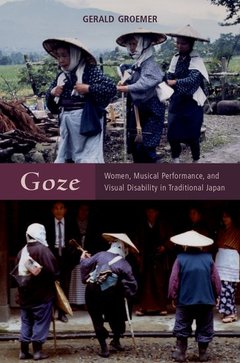Description
Goze
Women, Musical Performance, and Visual Disability in Traditional Japan
Author: Groemer Gerald
Language: English
Goze
Publication date: 06-2016
Support: Print on demand
Publication date: 06-2016
Support: Print on demand
Goze
Publication date: 05-2016
336 p. · 16.2x23.3 cm · Paperback
Publication date: 05-2016
336 p. · 16.2x23.3 cm · Paperback
Description
/li>Biography
/li>
In a tradition extending from the medieval era to the early twentieth century, visually disabled Japanese women known as goze toured the Japanese countryside as professional singers and contributed to the vitality of rural musical culture. The goze sang unique narratives (many requiring several hours to perform) as well as a huge repertory of popular ballads and short songs, typically accompanied by a three-stringed lute known as the shamisen. During the Edo period (1600-1868) goze formed guild-like occupational associations and created an iconic musical repertory. They were remarkably successful in fighting discrimination accorded to women, people with physical disabilities, the poor, and itinerants, using their specialized art to connect directly to the commoner public. The best documented goze lived in Echigo province in the Japanese northwest. Although their activities peaked in the nineteenth century, some women continued to tour until the middle of the twentieth. The last active goze survived until 2005. In Goze: Blind Women and Musical Performance in Traditional Japan, author Gerald Groemer argues that goze activism was primarily a matter of the agency of performance itself. Groemer shows that the solidarity goze achieved with the rural public through narrative and music was based on the convergence of the goze's desire to achieve social autonomy and the wish of lower-class to mitigate the cultural deprivation to which they were otherwise so often subject. It was this correlation of emancipatory interests that allowed goze to flourish and attain a degree of social autonomy. Far from being pitied as helpless victims, goze were recognized as masterful artisans who had succeeded in transforming their disability into a powerful social tool and who could act as agents of widespread cultural development. As the first full-length scholarly work on goze in English, this book is sure to prove an invaluable resource to scholars and students of Japanese culture, Japanese music, ethnomusicology, and disability studies worldwide.
Gerald Groemer began his studies of music as a pianist. After earning a Masters of Music and Doctorate of Musical Arts in piano performance at Peabody Conservatory, he entered the ethnomusicology program at Tokyo University of Fine Arts and Music where he earned a PhD in musicology in 1993, the first non-Japanese ever to do so. Since 1998 he has been professor of musicology, ethnomusicology, and Japanese music history at University of Yamanashi in K?fu Japan. He has authored several books on music and cultural history in both Japanese and English, including The Spirit of Tsugaru (2012), a translation Nishiyama Matsunosuke's writings on Edo Culture (1997), and Street Performers and Society in Urban Japan, 1600-1900: The Beggar's Gift (2015). He was awarded the prestigious Koizumi Fumio Prize for Ethnomusicology in 2008.
© 2024 LAVOISIER S.A.S.
These books may interest you

Focus: Music in Contemporary Japan 160.25 €



